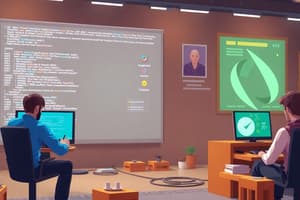Podcast
Questions and Answers
Define a game level as an environment or location in gaming.
Define a game level as an environment or location in gaming.
A game level refers to a specific environment or location where gameplay occurs, such as being on the Death Star level near the end of a game.
How does the concept of game levels relate to player progression?
How does the concept of game levels relate to player progression?
Game levels serve as a unit of counting a player's progression, particularly in games with repetitive gameplay, exemplified by achieving level 20 in Tetris.
What does it mean to level up a character in a game?
What does it mean to level up a character in a game?
To level up a character means to increase their rank based on earned score, experience, or skills, with examples like getting a character to level 70 in World of Warcraft.
What is the distinction between 'rounds' and 'waves' in gaming?
What is the distinction between 'rounds' and 'waves' in gaming?
In what contexts are the terms 'stage' and 'wave' commonly used in gaming?
In what contexts are the terms 'stage' and 'wave' commonly used in gaming?
How do 'acts' and 'chapters' enhance a player's experience in narrative-driven games?
How do 'acts' and 'chapters' enhance a player's experience in narrative-driven games?
What role do game levels play in determining a player's skill set?
What role do game levels play in determining a player's skill set?
Explain how developers utilize game levels to design gameplay experiences.
Explain how developers utilize game levels to design gameplay experiences.
What are some general limitations a game level designer must consider during the design process?
What are some general limitations a game level designer must consider during the design process?
How do level designers utilize 'zones' during the idea production stage?
How do level designers utilize 'zones' during the idea production stage?
What is the purpose of creating a Bubble Diagram in level game design?
What is the purpose of creating a Bubble Diagram in level game design?
After constructing a Bubble Diagram, what is the next step a designer takes in creating a level?
After constructing a Bubble Diagram, what is the next step a designer takes in creating a level?
What does the final stage of level design involve?
What does the final stage of level design involve?
Which factors should a designer consider when determining the target audience for a game level?
Which factors should a designer consider when determining the target audience for a game level?
Why is time management important during the game level design process?
Why is time management important during the game level design process?
Flashcards
Game Level (Environment)
Game Level (Environment)
A specific gameplay area or location within a game.
Game Level (Progression)
Game Level (Progression)
A unit of progression that indicates a player's advancement in a game.
Game Level (Rank)
Game Level (Rank)
A rank or score that represents a player's skill or ability.
Game Level (Developer Term)
Game Level (Developer Term)
Signup and view all the flashcards
Round
Round
Signup and view all the flashcards
Wave
Wave
Signup and view all the flashcards
Stage
Stage
Signup and view all the flashcards
Act/Chapter
Act/Chapter
Signup and view all the flashcards
Knowing Limitations
Knowing Limitations
Signup and view all the flashcards
Produce Ideas and Create Structure
Produce Ideas and Create Structure
Signup and view all the flashcards
What are Bubble Diagrams?
What are Bubble Diagrams?
Signup and view all the flashcards
Rough Maps
Rough Maps
Signup and view all the flashcards
Finishing the Level Design
Finishing the Level Design
Signup and view all the flashcards
What are limitations in game level design?
What are limitations in game level design?
Signup and view all the flashcards
Why is understanding target audience important in level design?
Why is understanding target audience important in level design?
Signup and view all the flashcards
Study Notes
Game Design - Levels
- Level Definition (1st): A level is an environment or location where gameplay occurs. An example: being on the Death Star level in a game means you're near the end.
- Level Definition (2nd): A level is a unit of progress for the player, especially when gameplay is repetitive. An example: reaching level 20 in Tetris.
- Level Definition (3rd): Levels indicate a player's rank based on earned score, experience, or skills. This marks character progression and improvement. An example: leveling up a Warcraft character to 70.
- Level Definition (4th): Levels are a division of physical space in a game, broken down based on experience. An example: dying many times on a mine cart level in a game.
- Related Term: Rounds: These are used in games and sports where the same or similar actions/activities are repeated. An example might be rounds in golf or a sport like Peggle or Diner Dash.
- Related Term: Waves: These involve repeated combat against enemies in a game. An example: waves of enemies in a game like Plants vs. Zombies, or Gears of War 2.
- Related Term: Stage: This is similar to the idea of a level, but usually separates parts of an experience. It’s often used when areas in a game have clear separation. Examples include interactions with boss enemies or sequences that are distinct like a stage in a video game.
- Related Term: Acts/Chapters: A more sophisticated method of dividing a game into parts, often to emphasize a narrative or story element. These don't necessarily have a distinct physical mapping like an environmental level. Game levels may be structured using acts/chapters but they can also be structured in other ways. This is a development choice.
Stages of Level Design
- Stage 1: Knowing Limitations: Game designers must consider certain factors that constrain a level, like the length of a level, the technology used in creating the environment (audio, art, presentation), the time available for development, customer needs, platform capabilities or specifications, and the intended target audience.
- Stage 2: Produce Ideas and Create Structure: Level design teams come up with initial ideas and a central story thread for the level. Sometimes, to streamline work, level designers might break the level design into discrete "zones," designing each zone separately.
- Stage 3: Bubble Diagrams: A bubble diagram is a simple map of a whole level. This map uses circles to show different areas and arrows show the flow or connections between those areas. Bubble diagrams help visualize the relationships between locations.
- Stage 4: Rough Maps: Once the level connections are clear via the bubble diagrams, a rough map is created for each area or bubble in the level. This is a blueprint for the layout of the level.
- Stage 5: Finishing the Level Design: This involves connecting the previous elements (stages) within the level into a cohesive physical space. All the elements are fine-tuned, from details to the heights and distances of different locations. Details like heights, locations of environmental objects, and paths are marked and finalized.
Studying That Suits You
Use AI to generate personalized quizzes and flashcards to suit your learning preferences.





